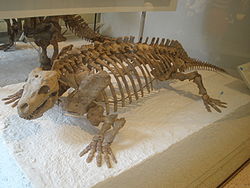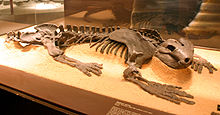- Diadectes
-
Diadectes
Temporal range: Cisuralian - Guadalupian, 299–271 MaMounted skeleton of D. sideropelicus, American Museum of Natural History Scientific classification 
Kingdom: Animalia Phylum: Chordata Class: Amphibia (unranked): Reptiliomorpha Suborder: †Diadectomorpha Family: †Diadectidae Genus: †Diadectes
Cope, 1878Type species Diadectes sideropelicus
Cope, 1878Species D. lentus (Marsh, 1878)
D. sideropelicus Cope, 1878
D. tenuitectus Cope, 1896
D. carinatus (Case & Williston, 1912)
D. sanmiguelensis Lewis & Vaughn, 1965
D. absitus Berman et al., 1998Synonyms Nothodon Marsh, 1878
Empecocles Cope, 1878
Helodectes Cope, 1880
Empedias Cope, 1883
Chilonyx Cope, 1883
Bolbodon Cope, 1896
Diadectoides Case, 1911
Animasaurus Case & Williston, 1912Diadectes (meaning biter-through or penetrating bite) was a genus of large, very reptile-like amphibians that lived during the early Permian period (Cisuralian - Guadalupian epochs, between 299 and 271 million years ago[1]). It is one of the very first herbivorous tetrapods, and also one of the first fully terrestrial animals to attain large size.
Contents
Description
Diadectes was a heavily built animal, 1.5 to 3 meters long, with a thick-boned skull, heavy vertebrae and ribs, massive limb girdles and short, robust limbs. The nature of the limbs and vertebrae clearly indicate a terrestrial animal.
Paleobiology
It possesses some characteristics of reptilians and amphibians, combining a reptile-like skeleton with a more primitive, seymouriamorph-like skull. Diadectes has been classified as belonging to the sister group of the amniotes.
Among its primitive features, Diadectes has a large otic notch (a feature found in all labyrinthodonts, but not in reptiles) with an ossified tympanum. At the same time its teeth show advanced specialisations for a herbivorous diet that are not found in any other type of early Permian animal. The eight front teeth are spatulate and peg-like, and served as incisors that were used to nip off mouthfuls of vegetation. The broad blunt cheek teeth show extensive wear associated with occlusion, and would have functioned as molars, grinding up the food. It also had a partial secondary palate, which meant it could chew its food and breath at the same time, something many even more advanced reptiles were unable to do.
These traits are likely adaptations related to the animals high fiber herbivorous diet, and evolved independently of similar traits seen in some reptilian groups. Many of the reptile-like details of the post-cranial skeleton are possibly related to carrying the substantial trunk, these may be independetly derived traits on Diadectes and their relatives. Though very similar, they would be anaologous rather than homologous to those of early amniotes like pelycosaurs and pareiasaurs, as the first reptiles evolved from small, swamp dwelling animals like Casineria and Westlothiana.[2][3]
Discovery
Diadectes fossil remains are known from a number of locations across North America, especially the Texas Red Beds (Wichita and Clear Fork).
Classification and species
Numerous species have been assigned to Diadectes, though most of those have proven to be synonyms of one another. Similarly, many supposed separate genera of diadectids have been shown to be junior synonyms of Diadectes. One of these, Nothodon, was actually published by Othniel Charles Marsh five days before the name Diadectes was published by his rival Edward Drinker Cope. Despite this fact, in 1912 Case synonymized the two names and treated Diadectes as the senior synonym, which has been followed by other paleontologists since, despite the fact that it violates the rules of biological nomenclature.[1]
References
- ^ a b Kissel, R. (2010). "Morphology, Phylogeny, and Evolution of Diadectidae (Cotylosauria: Diadectomorpha)." Thesis (Graduate Department of Ecology & Evolutionary Biology University of Toronto).
- ^ Carroll R.L. (1991): The origin of reptiles. In: Schultze H.-P., Trueb L., (ed) Origins of the higher groups of tetrapods — controversy and consensus. Ithaca: Cornell University Press, pp 331-353.
- ^ Laurin, M. (2004): The Evolution of Body Size, Cope's Rule and the Origin of Amniotes. Systematic Biology no 53 (4): pp 594-622. doi: 10.1080/10635150490445706 article
- Parker, Steve. Dinosaurus: the complete guide to dinosaurs. Firefly Books Inc, 2003. Pg. 83
- Benton, M. J. (2000), Vertebrate Paleontology, 2nd ed. Blackwell Science Ltd
- Carroll, R. L. (1988), Vertebrate Paleontology and Evolution, WH Freeman & Co.
- Colbert, E. H., (1969), Evolution of the Vertebrates, John Wiley & Sons Inc (2nd ed.)
- Reisz, Robert, (no date), Biology 356 - Major Features of Vertebrate Evolution - Anthracosaurs and Diadectomorphs
Categories:- Permian animals
- Reptiliomorphs
- Prehistoric animals of North America
Wikimedia Foundation. 2010.




